Cat Ear Yeast Infection: From the POV of a Cat Parent

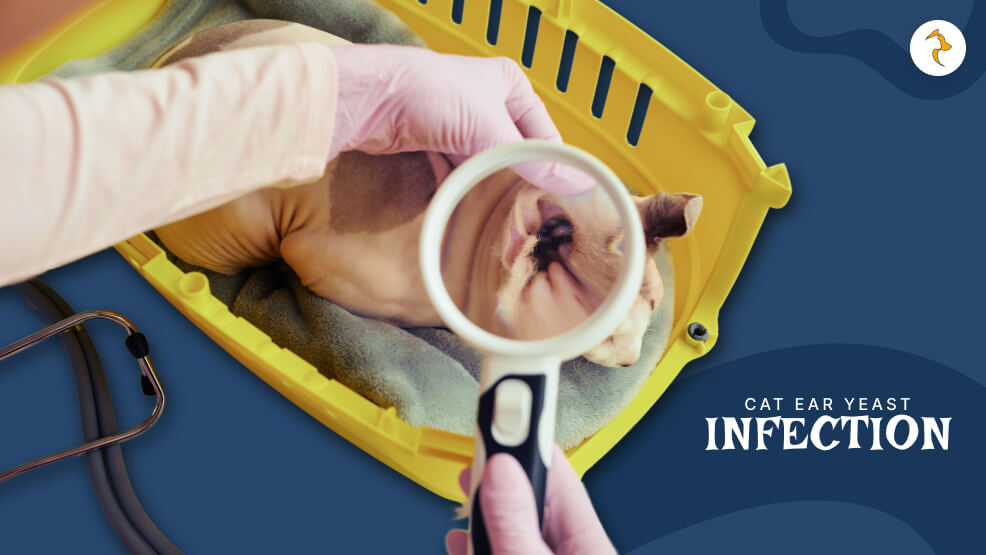
Cats are clean and tidy pets, but the neatest and cleanest of cats cannot escape from medical conditions. One such condition is an cat ear yeast infection.
As disgusting as this may sound, cat ear yeast infection is wickedly painful, can cause other, more serious illnesses, and must be treated right away.
All this article is intended for educational purposes only on educating the owner of a cat about the etiology, clinical presentation, diagnosis, treatment, home care, prevention, and long-term care of an ear yeast infection in a cat.
What Is a Cat Ear Yeast Infection?
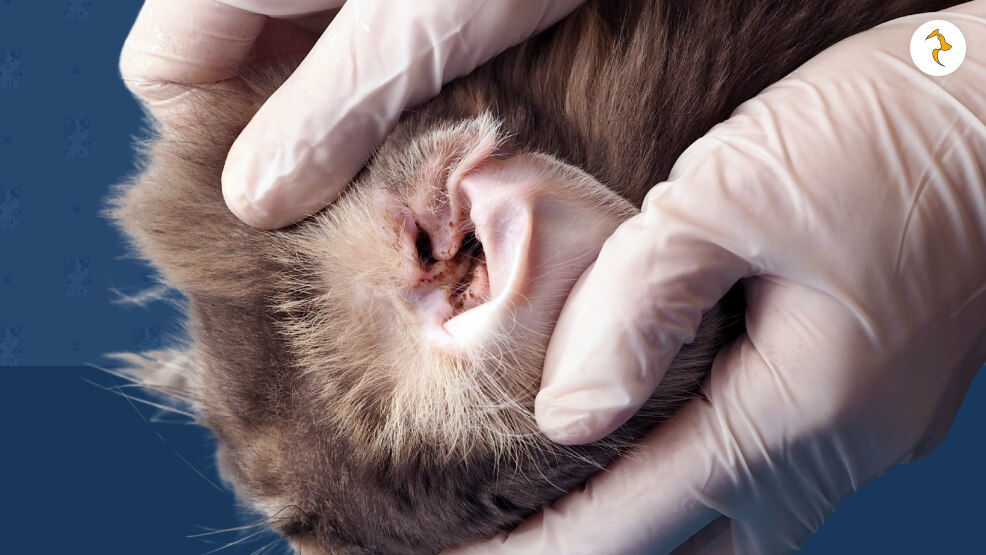
A cat ear yeast infection is generally a consequence of aberrant excess growth of the yeast organism Malassezia pachydermatis, which is a common inhabitant of the skin and ears in the majority of animals. The yeast may possess the ability to progress to infection where the ear condition is oily, warm, and damp.
Whereas a healthy low cell count of Malassezia is normal, overgrowth is responsible for irritation, odor, discharge, and itch, the earmarks of an ear yeast infection.
If not treated, infections are passed on to inner ear tissue, become a pain center, and even lead to partial deafness.
Ear Yeast Infections in Cats: Causes
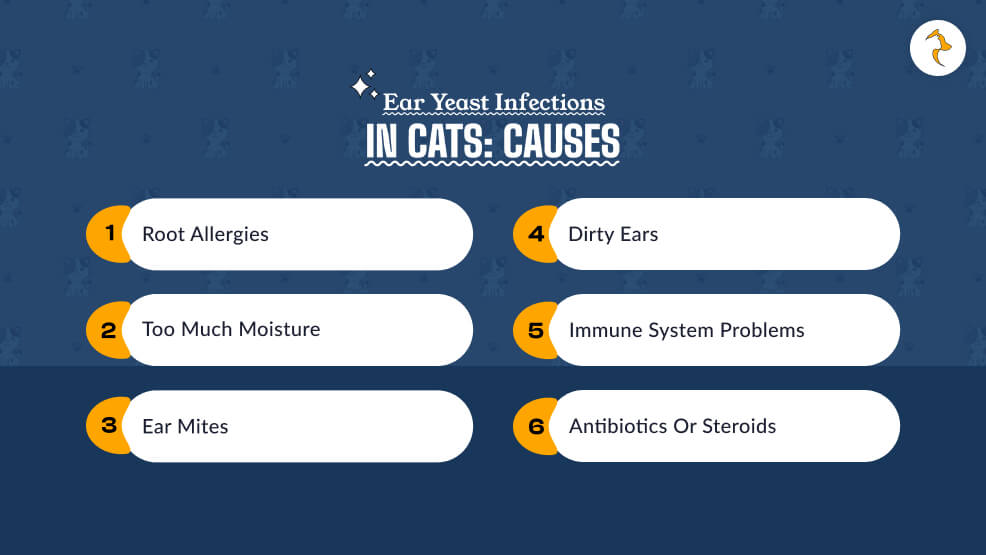
There are a few basic reasons upon which the cat ear yeast infection can be based. They are easy to prevent and treat with knowledge of them:
1. Root Allergies
- Food allergies: Chicken, beef, or grains are a few of the food proteins which can cause allergic reactions and manifest in the form of themselves within the cat ears.
- Environmental allergies: Allergens from pollen, dust mite, mold, and dander irritate the ear canal and traumatize the equilibrium of the ear canal.
2. Too Much Moisture
- Excess moisture due to too much bathing, exposure to water, or rain is a yeast enthusiast.
- Longhaired or floppie eared breeds keep moisture, thus they are more dangerous.
3. Ear Mites
- Ear mite discomfort and scratch induce micro-trauma that the yeast will exploit.
- Secondary infection typically follows a mite infestation.
4. Dirty Ears
- Forgetting to clean regularly gives wax, sebum, and dirt an opportunity to build up—yeast’s smorgasbord.
5. Immune System Problems
- FIV (Feline Immunodeficiency Virus) or FeLV (Feline Leukemia Virus)-positive cats are immunocompromised and susceptible to becoming infected with fungi.
6. Antibiotics or Steroids
- Broad-spectrum antibiotics kill good bacteria, and yeast overgrows.
- Corticosteroids, when given long-term, also dampen immune function.
Symptoms of a Cat Ear Yeast Infection
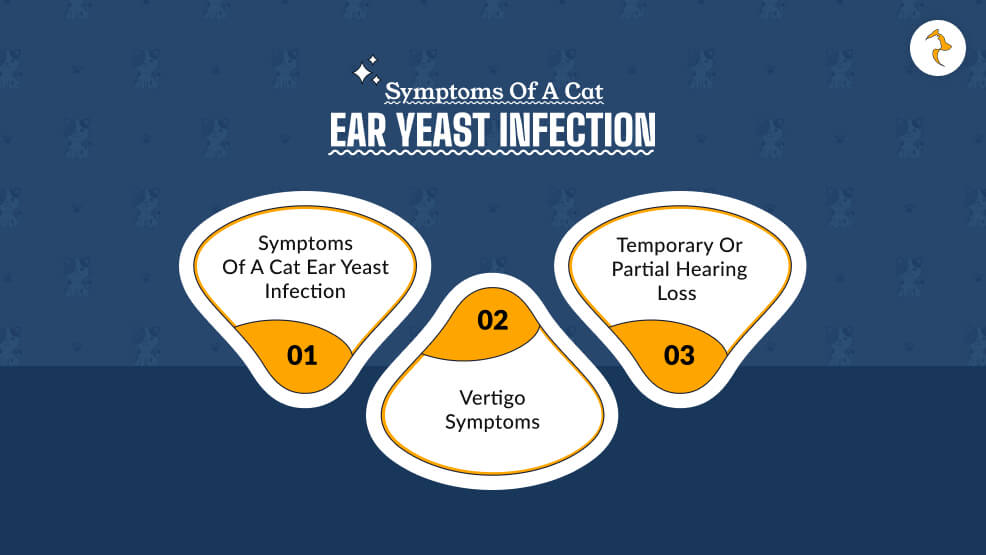
Early identification of symptoms will give best chance for success with the treatment. Symptoms and signs can be:
Frenzied head shaking or pawing at ear Repeatedly head shaking or tilting Swelling, warmth, or redness of ear flap or canal Brown, dark-colored, yellowish, or black discharge of wax Bad yeasty or foul musty odor.
Crusting or scabbing of the outer ear Hair loss around and within ears due to chronic scratching
- Ear touching or vocalization sensitivity
- Vertigo symptoms or loss of balance (in case of severe infection of the inner ear)
- Temporary or partial hearing loss
Cat Ear Yeast Infection Diagnosis
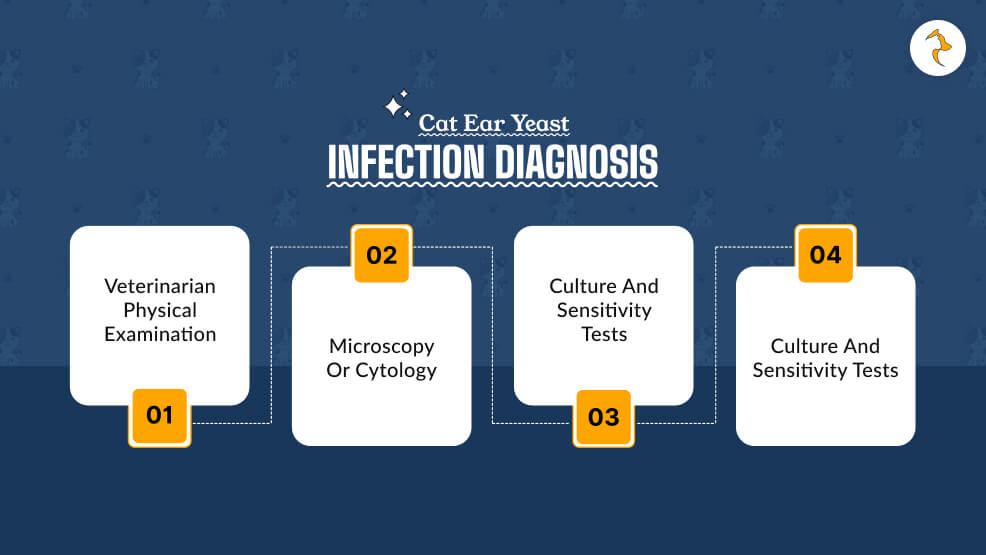
Early proper diagnosis is the salvation of treatment and complication prevention:
1. Veterinarian Physical Examination
- Physical examination will look for discharge, redness, and condition of ear canal.
- An otoscope permits viewing down into the ear depth.
2. Microscopy or Cytology
- With a microscope, there is an ear swab to detect Malassezia yeast cells and other infective (e.g., mites, bacteria).
3. Culture and Sensitivity Tests
- With recurrences and resistance, a culture cultivates one fungal strain and decides what medicine to administer.
4. Allergy and Sensitivity Testing
- Allergen testing of food and the environment can be recommended by the veterinarian in the event of repeated infections.
Treatment of Cat Ear Yeast Infection
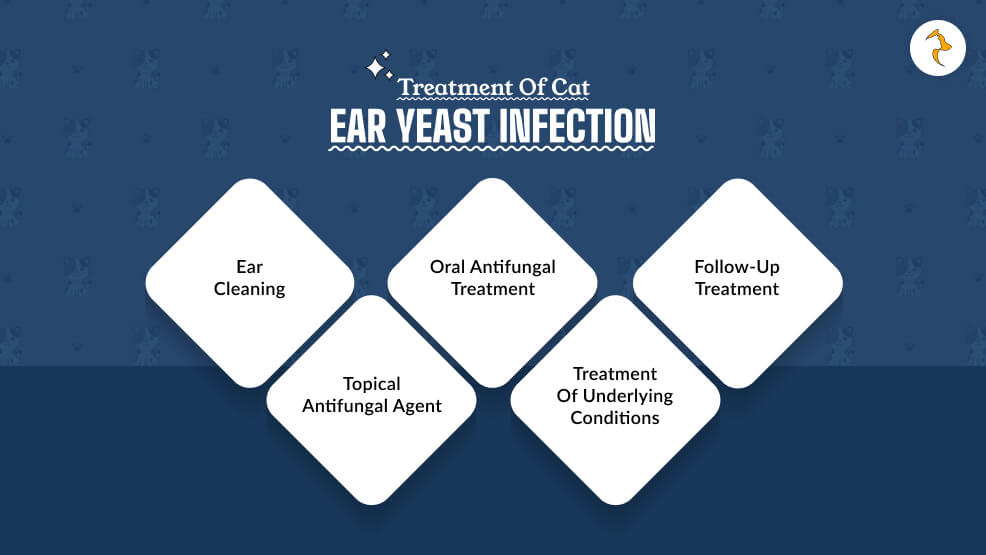
Treatment of the causative organism and the yeast:
1. Ear Cleaning
- Prescription veterinary ear cleaners applied topically to drain wax, discharge, and debris.
- Cleaning facilitates penetration by the drug and also lowers the yeast load.
2. Topical Antifungal Agent
- Active ingredients typically consist of miconazole, clotrimazole, and ketoconazole.
- Combination ear drops can contain antibiotics and corticosteroids for co-infection and inflammation.
3. Oral Antifungal Treatment
- Severe or chronic infection with medications such as itraconazole or fluconazole.
- Monitoring by the liver might be required if administered chronically.
4. Treatment of Underlying Conditions
- Ear mites’ treatment: Antiparasitic drug (e.g., selamectin, ivermectin)
- Treatment of allergy: Hypoallergenic diet, antihistamines, or immunotherapy
- Immune support role: Treatment of underlying illness, diet
5. Follow-Up Treatment
- Follow-up ear examination and cytology
- Coordinate treatment plans with response and secondary findings
- Daily chronic ear maintenance
Follow-Up Home Care and Ear Maintenance Instructions
Successful home care supports the vet’s treatment and prevents recurrence:
- Clean ears only as directed by your vet
- Use gauze or soft cotton plugs; Q-tips push dirt in deeper
- Pre-warming cleaning solution to room temperature for use
- Dry ears after bath or cleaning
- Peaceful and quiet environment during the cleaning time
- Pamper and love later so it can be turned into a pleasure activity
6 Ways Not to Get Ear Yeast Infection in Cat
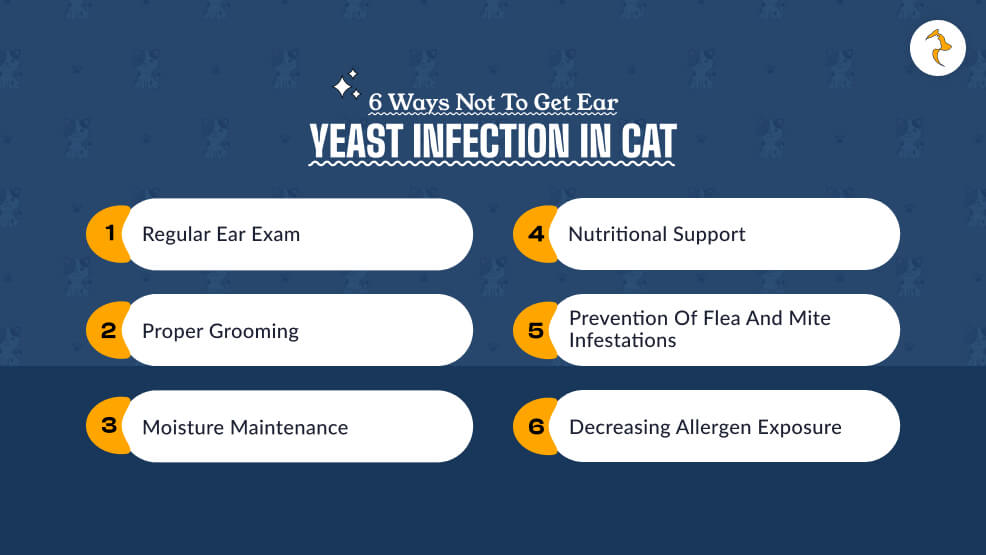
Here are 6 possible ways to control cat ear yeast infection and not let that happen anymore.
1. Regular Ear Exam
- Each month inspect for dirt, wax, redness, or bad smell
2. Proper Grooming
- Clip excess ear hair for long-haired cat
- Brush daily to decrease dander and allergens
3. Moisture Maintenance
- Dry completely after wet exposure
- Use vet-approved ear-drying powders when necessary
4. Nutritional Support
- Feed balanced, species-formula diet with added essential fatty acids
- Supplement with probiotics for immune and skin well-being
5. Prevention of Flea and Mite Infestations
- Give monthly parasite preventatives to prevent infestations that lead to secondary infections
6. Decreasing Allergen Exposure
- Use air purifiers, wash the bedding, and vacuum as necessary
- Do not smoke and also spraying perfume in the presence of the cat
When to Visit a Veterinarian
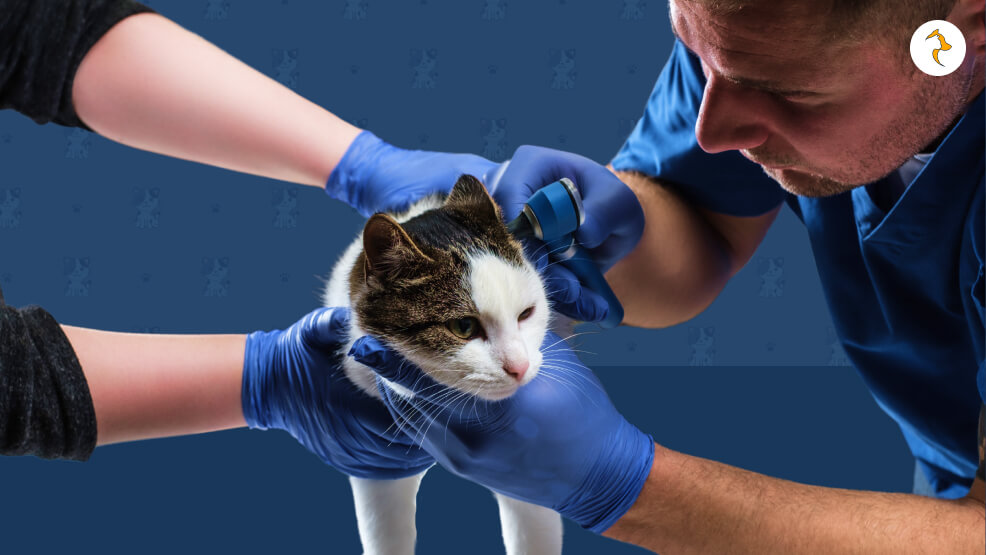
Don’t try to treat suspected yeast infections yourself. Visit a vet if:
- Cat over-grooms or head-shakes
- Yellow or smelly discharge
- Pain, lethargy, or loss of balance
- Drug fails within a few days
- Infection comes and goes repeatedly
Time lag will result in otitis media (infection of the middle ear), hearing loss, or deep tissue infection.
FAQs
Here are a few FAQs on the topic of cat ear yeast infection that you might find useful.
Malassezia is not usually zoonotic. Hands must be washed after having contact with dogs and cats in immunosuppressed patients.
Immunocompetent patients will also have secondary folliculitis due to self-inflicted trauma in the role of good skin hygiene.
No. It is made worse by misdiagnosis and/or treatment. You will need to phone your vet first and receive proper diagnosis and treatment advice.
Yes. Particularly if secondary disease such as allergy or immunosuppression is not on treatment. Some cats must be kept on a lifetime of monitoring.
Yes. Swelling and inflammation are painful and tender, and therefore the treatment must be started right away.
Prevention long-term depends on ongoing cleanliness, vigilant watchfulness for early signs, and management of recurrence causes.
Keeping the Ears Purrfect!
A cat ear yeast infection is not fun and is painful for your cat. But, with prompt vet treatment for your cat, proper grooming, and a treatment given with medication, your pet will be back on track.
The whys, being in preventative maintenance mode, and monitoring the ears of your cat to look for disease is the solution for not having this type of infection.
Remember, if your cat ever indicates the slightest sign of ear pain or infection, don’t delay. Treating it early not only fixes the problem at hand, but prevents future chronic ones from taking hold.







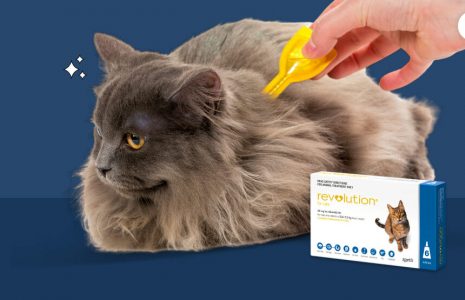

Leave A Comment